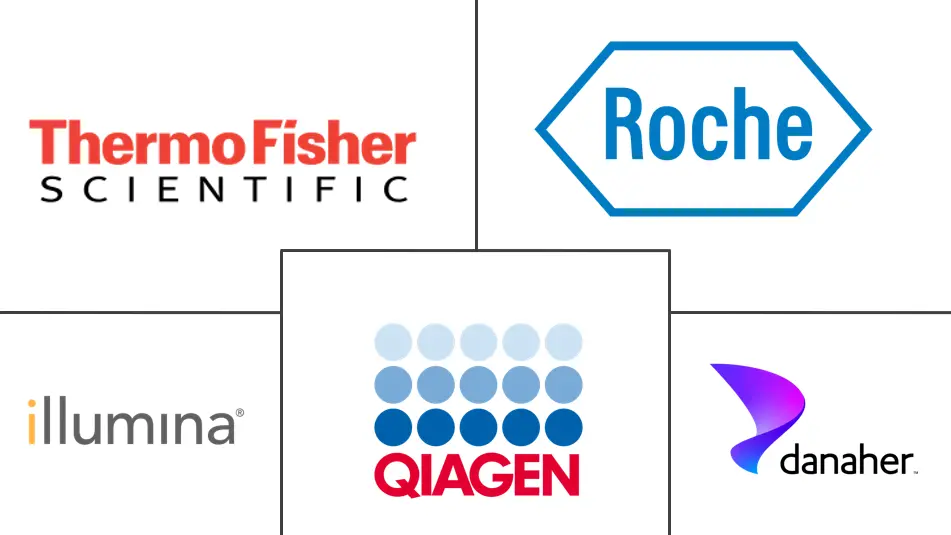Oncology Molecular Diagnostics Market Size and Share
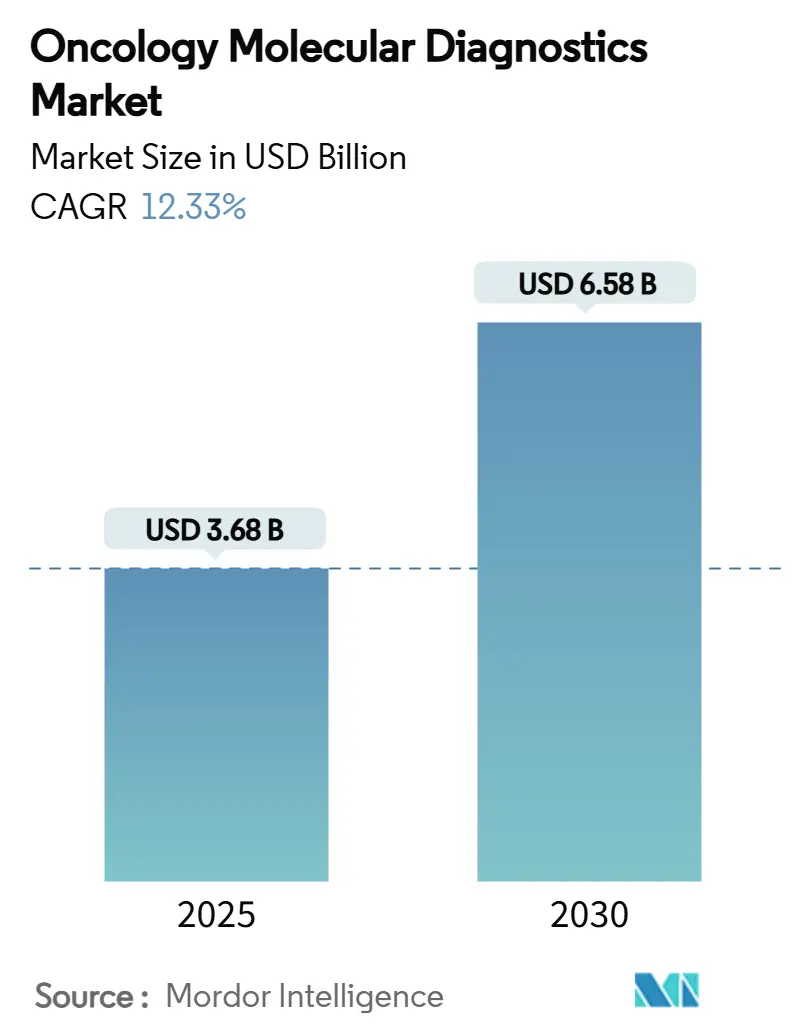
Oncology Molecular Diagnostics Market Analysis by Mordor Intelligence
The Oncology Molecular Diagnostics Market size is estimated at USD 3.68 billion in 2025, and is expected to reach USD 6.58 billion by 2030, at a CAGR of 12.33% during the forecast period (2025-2030).
Companion diagnostics linked to targeted therapies, expanding liquid biopsy approvals, and AI-enabled bioinformatics are accelerating clinical uptake. Demand is also fueled by national genomics programs that improve reimbursement frameworks and by the rising prevalence of cancer, which drives multiple molecular tests per patient along the treatment continuum. Meanwhile, point-of-care platforms are moving sophisticated assays out of centralized laboratories, shrinking turnaround times and broadening access. Competitive dynamics favor vertically integrated leaders that pair proprietary reagents with analytics software, while niche innovators leverage AI and liquid biopsy technologies to capture white-space opportunities within the oncology molecular diagnostics market.
Key Report Takeaways
- By product type, reagents and consumables held 62.13% oncology molecular diagnostics market share in 2024, whereas software and services post a 15.41% CAGR to 2030.
- By technology, PCR led with 35.09% revenue share in 2024; next-generation sequencing expands at a 13.65% CAGR through 2030.
- By cancer type, breast cancer commanded 18.17% of the oncology molecular diagnostics market size in 2024, while lung cancer records the highest 12.83% CAGR to 2030.
- By sample type, tissue biopsy retained 71.34% share of the oncology molecular diagnostics market in 2024; liquid biopsy advances at a 14.32% CAGR to 2030.
- By end user, hospitals and academic centers captured 55.48% revenue in 2024, whereas point-of-care sites grow at a 13.17% CAGR through 2030.
- By geography, North America led with a 40.18% revenue share in 2024. Asia-Pacific registered the fastest 16.08% CAGR from 2025-2030, outpacing North America’s mature base.
Global Oncology Molecular Diagnostics Market Trends and Insights
Drivers Impact Analysis
| Driver | (~) % Impact on CAGR Forecast | Geographic Relevance | Impact Timeline |
|---|---|---|---|
| Uptake of liquid-biopsy companion diagnostics | +2.4% | North America, Europe, Asia-Pacific | Medium term (2-4 years) |
| National genomics reimbursement initiatives | +1.9% | Asia-Pacific, Oceania, Europe | Long term (≥ 4 years) |
| AI-driven bioinformatics reducing NGS turnaround | +1.6% | North America, Europe | Short term (≤ 2 years) |
| Increasing demand for point-of-care testing | +1.1% | Global | Short term (≤ 2 years) |
| Rising cancer prevalence | +1.2% | Global | Long term (≥ 4 years) |
| Multi-omics integration for comprehensive profiling | +0.9% | North America, Europe | Medium term (2-4 years) |
| Source: Mordor Intelligence | |||
Liquid-biopsy companion diagnostics transforming treatment pathways
FDA approvals for liquid biopsy companion diagnostics have multiplied since 2023, enabling real-time genomic monitoring without invasive tissue sampling. FoundationOne Liquid CDx now guides MET exon 14 skipping therapy in non-small cell lung cancer, expanding precision care to patients with limited tissue.[1]Foundation Medicine Editorial Team, “FoundationOne Liquid CDx Receives New FDA Approval,” Foundation Medicine, foundationmedicine.com Clinical adoption is rising because the assays detect resistance mutations before imaging changes appear, letting oncologists switch therapies earlier and improving outcomes.
National genomics initiatives accelerating reimbursement frameworks
Programs such as Australia’s PrOSPeCT offer 23,000 patients free genomic testing funded by USD 185 million, demonstrating how coordinated policy, clinical trial access, and coverage decisions converge to democratize precision oncology.[2]UNSW Media Office, “PrOSPeCT to Deliver Genomic Testing for 23,000 Australians,” UNSW, unsw.edu.au As similar schemes roll out in China and Japan, standardized protocols lower payer uncertainty, expanding compensated testing indications across the oncology molecular diagnostics market.
AI-driven bioinformatics slashing NGS turnaround times
Machine learning now automates variant calling and clinical annotation, trimming manual review by up to 60% and compressing result delivery from days to hours.[3]National Institute for Biological Standards and Control, “Cloud Computing Accelerates Genomic Analysis,” NIBSC, nibsc.org Cloud-based pipelines process multiple genomes in parallel, making comprehensive profiling feasible within routine oncology visits and enhancing the competitiveness of point-of-care offerings.
Increasing demand for point-of-care testing
Microfluidic cartridges and isothermal amplification systems shift molecular diagnostics into ambulatory oncology clinics, cutting sample logistics and enabling same-day treatment decisions. Community oncologists gain the ability to start targeted regimens immediately, boosting test volumes and reinforcing the decentralization trend within the oncology molecular diagnostics market.
Restraint Impact Analysis
| Restraint | (~) % Impact on CAGR Forecast | Geographic Relevance | Impact Timeline |
|---|---|---|---|
| Shortage of genomic pathologists | −1.5% | Latin America | Medium term (2-4 years) |
| High cost of molecular diagnostic tests | −1.3% | Emerging markets | Long term (≥ 4 years) |
| Sensitivity & QC challenges in liquid-biopsy ctDNA testing | −1.0% | Global | Short term (≤ 2 years) |
| Lack of skilled workforce & stringent regulation | −0.8% | Asia-Pacific, Africa | Medium term (2-4 years) |
| Source: Mordor Intelligence | |||
Genomic pathologist shortage creating diagnostic bottlenecks
Only 3% of pathology departments report adequate staffing of genomic specialists, with Latin America most affected. Limited expertise constrains report interpretation and delays clinical decision making. Teleconsultation networks and AI decision support mitigate but do not fully resolve the capacity gap, tempering growth in regions with the greatest need.
Cost barriers limiting adoption in emerging markets
Comprehensive genomic profiling still costs USD 3,000-5,000 per patient, straining budgets where reimbursement is nascent. While reagent prices fall, infrastructure and quality-control requirements maintain a high baseline expense. Regional reference labs and scaled procurement aim to spread fixed costs, yet affordability remains a hurdle that dampens oncology molecular diagnostics market penetration in middle-income countries.
Segment Analysis
By Product Type: Reagents dominance reinforced by software acceleration
Reagents and consumables generated 62.13% revenue in 2024, reflecting recurrent demand and proprietary chemistries that capture low-abundance mutations. This strong position anchors steady cash flows for manufacturers within the oncology molecular diagnostics market. Software and services, although smaller today, rise at a 15.41% CAGR as cloud-hosted analytics automate interpretation and reduce the need for scarce genomic pathologists.
Growth in AI-powered platforms positions bioinformatics as a strategic moat. Vendors bundling reagents with subscription-based interpretation tools secure end-to-end integration, fostering customer stickiness. The oncology molecular diagnostics software solutions market size is projected to expand markedly as laboratories seek efficiency gains and standardized reporting.
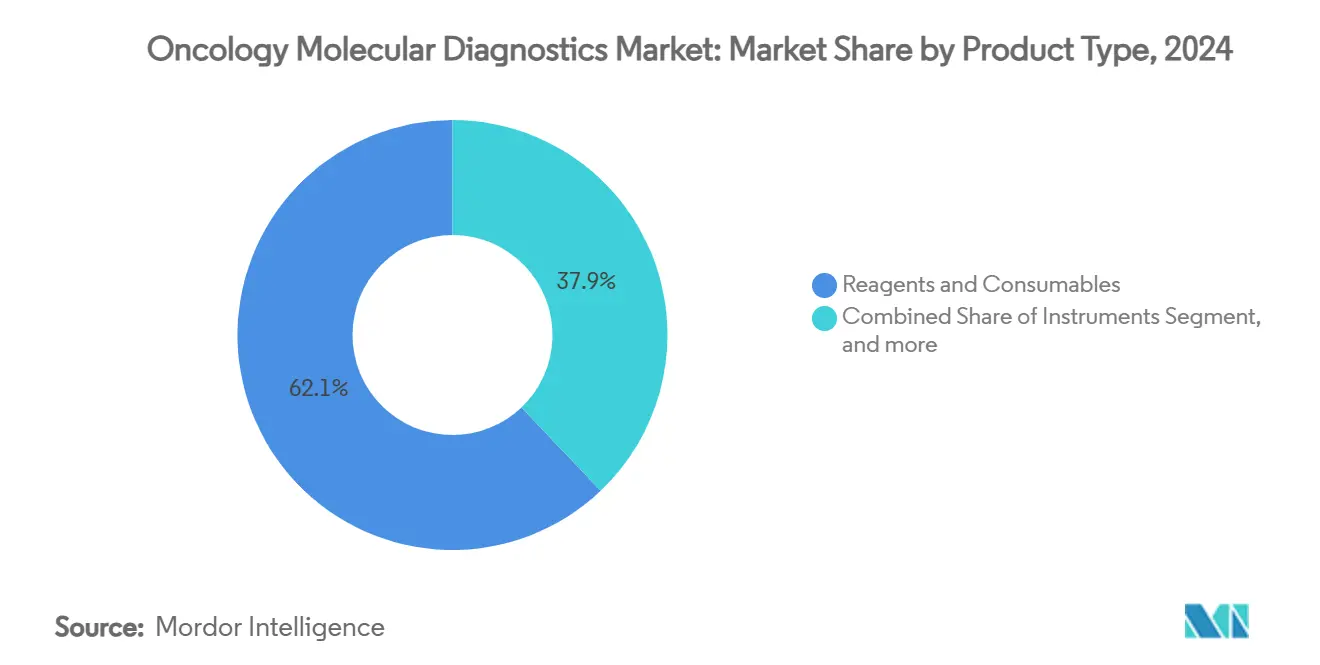
Note: Segment shares of all individual segments available upon report purchase
By Technology: PCR leadership persists while NGS momentum builds
PCR delivered 35.09% revenue in 2024 as laboratories value its cost efficiency and reliability. Digital PCR further extends sensitivity for detecting rare variants in liquid biopsy. In parallel, next-generation sequencing enjoys a 13.65% CAGR, propelled by declining run costs and broader clinical utility. Hybrid capture panels detect hundreds of genes in one assay, transforming treatment selection.
NGS adoption also benefits from combined tissue and plasma workflows that reveal tumor heterogeneity. As laboratories validate liquid biopsy NGS panels, the oncology molecular diagnostics market size for comprehensive profiling grows faster than single-gene PCR assays, yet PCR remains indispensable for rapid single-mutation confirmation.
By Cancer Type: Breast cancer leadership meets surging lung cancer demand
Breast cancer testing contributed 18.17% of 2024 revenue, sustained by established biomarkers such as HER2 and estrogen receptors. Routine testing ensures consistent volume and underpins reagent consumption in the oncology molecular diagnostics market. Lung cancer, however, records the highest 12.83% CAGR thanks to extensive biomarker panels that include EGFR, ALK, ROS1, and KRAS mutations.
Liquid biopsy companion diagnostics for lung cancer remove tissue constraints, broadening eligible patient pools. Consequently, the oncology molecular diagnostics market share of lung cancer assays is projected to narrow the gap with breast cancer, driven by payer coverage and inclusion in clinical guidelines.
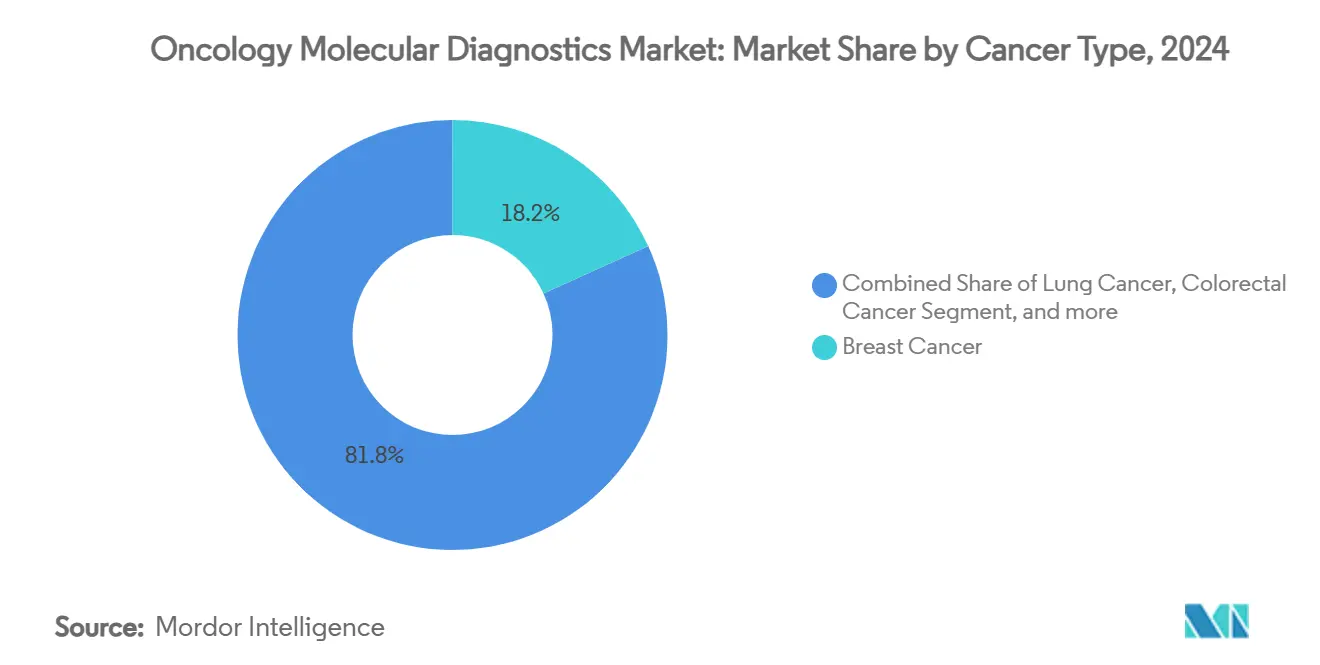
Note: Segment shares of all individual segments available upon report purchase
By Sample Type: Liquid biopsy disrupting traditional paradigms
Tissue biopsy retained 71.34% share in 2024, remaining the histopathological gold standard for initial diagnosis. Yet liquid biopsy revenue climbs at a 14.32% CAGR as non-invasive blood tests facilitate continuous monitoring. Regulatory approvals establish clinical confidence, and patients prefer serial blood draws over repeat tissue procedures.
Serial molecular monitoring detects emerging resistance sooner than imaging, an advantage that fuels adoption. As laboratories standardize circulating tumor DNA workflows, the oncology molecular diagnostics market size for liquid biopsy is set to rise in parallel with expanding companion diagnostic indications.
By End User: Decentralization to point-of-care settings
Hospitals and academic centers generated 55.48% revenue in 2024, aided by advanced infrastructure and multidisciplinary teams. Yet point-of-care locations register a 13.17% CAGR as cartridge-based platforms simplify testing. Community oncologists gain timely genomic insights without sending samples to central labs.
The trend aligns with value-based care goals that favor rapid decision making. Vendors offering compact analyzers with integrated bioinformatics will capture share as the oncology molecular diagnostics market shifts toward patient-centric delivery models.
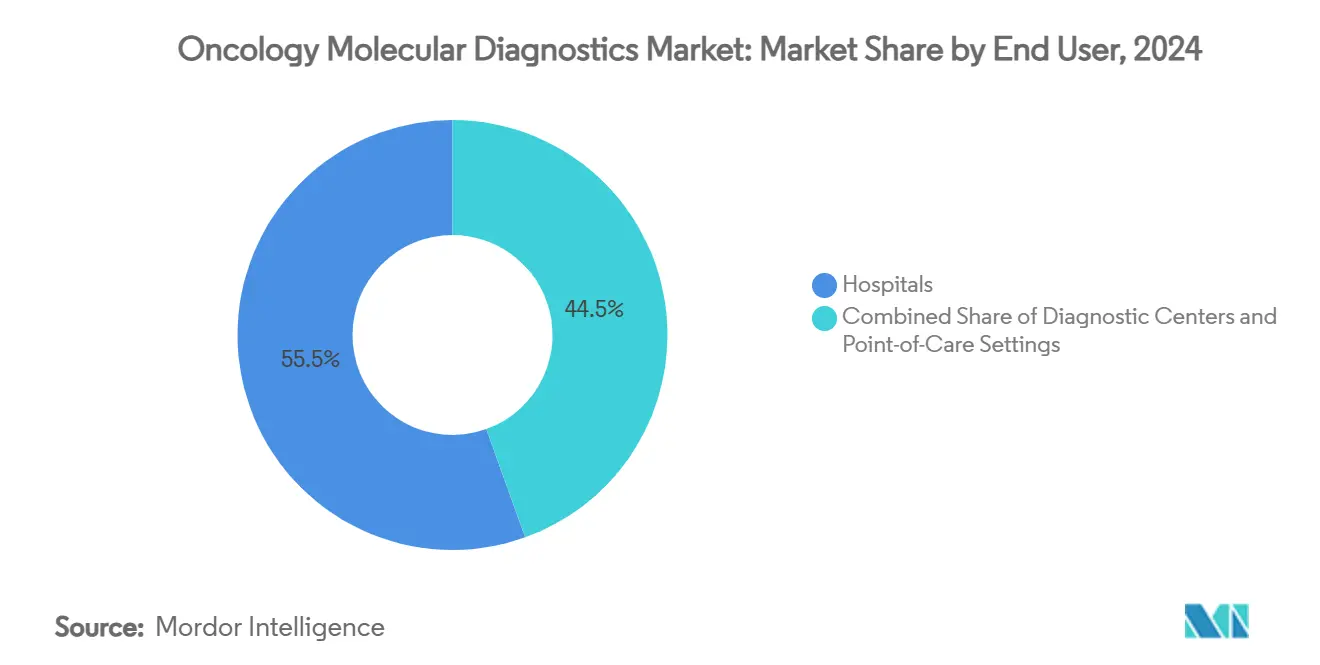
Note: Segment shares of all individual segments available upon report purchase
Geography Analysis
North America accounted for 40.18% revenue in 2024, leveraging early regulatory approvals and broad insurance coverage for comprehensive genomic profiling. Testing rates for actionable biomarkers approach 90% in leading cancer centers. Expanded Medicare coverage for minimal residual disease tracking further enlarges the oncology molecular diagnostics market.
Europe adopts a cost-effectiveness lens, leading to selective uptake but consistent reimbursement once clinical utility is proven. Harmonized companion diagnostic and drug approvals by the European Medicines Agency ensure synchronized market entry, supporting stable growth moderated by budget impact assessments.
Asia-Pacific posts the fastest 16.08% CAGR supported by China’s precision medicine plan and Japan’s genomic cancer program. Investments in national sequencing networks and public-private partnerships lower per-test costs and accelerate technology transfer. As local innovators refine assays for region-specific mutations, the oncology molecular diagnostics market size in Asia-Pacific expands rapidly with rising cancer incidence and improving healthcare infrastructure.
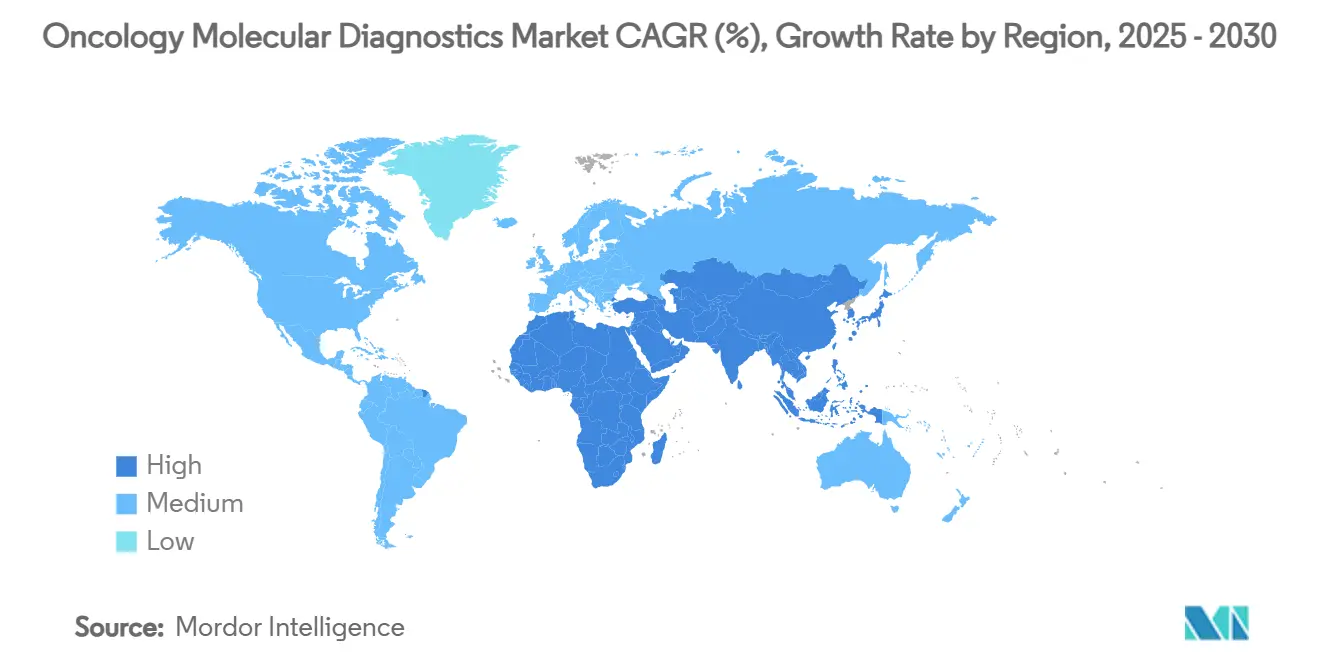
Competitive Landscape
Market leaders such as Roche, Thermo Fisher Scientific, and Abbott pursue vertical integration that mates proprietary reagents with automation and analytics. Roche’s control of Foundation Medicine secures a pipeline of FDA-approved comprehensive genomic profiling assays, anchoring its presence across both tissue and liquid biopsy segments. Thermo Fisher leverages Ion Torrent platforms bundled with turnkey informatics to lock in consumable pull-through.
Disruptive entrants specialize in AI analytics or niche sample types. Companies like Guardant Health and Agilent advance liquid biopsy platforms, while Ataraxis AI launches prediction algorithms that refine treatment planning. Strategic partnerships proliferate; Hitachi High-Tech teams with Gencurix to co-develop biomarkers adjusted for Japanese patient profiles. Consolidation continues as incumbents acquire innovators to secure technology leadership and sustain margins in the oncology molecular diagnostics market.
Oncology Molecular Diagnostics Industry Leaders
-
Illumina Inc.
-
Qiagen N.V.
-
F. Hoffmann-La Roche Ltd
-
Thermo Fisher Scientific Inc.
-
Danaher Corporation
- *Disclaimer: Major Players sorted in no particular order
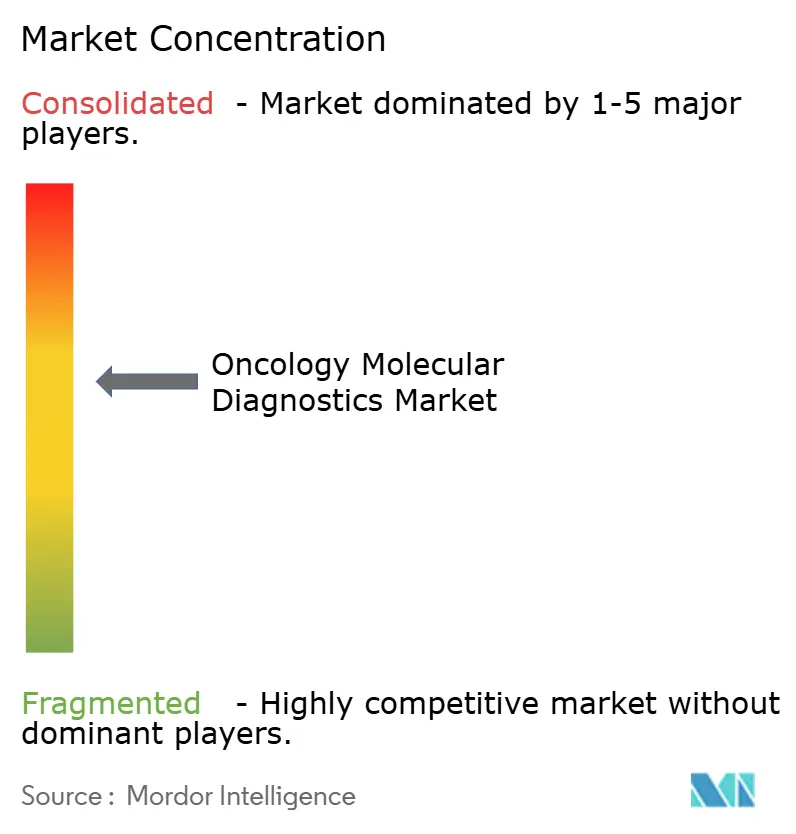
Recent Industry Developments
- November 2024: Foundation Medicine received FDA approval for FoundationOne Liquid CDx as the first companion diagnostic for TEPMETKO (tepotinib) to identify patients with MET exon 14 skipping alterations in non-small cell lung cancer.
- October 2024: Ataraxis AI, a leader in AI-driven precision medicine, has emerged from stealth mode with the announcement of securing USD 4 million in seed financing. The funding, raised in 2023 and co-led by Giant Ventures and Obvious Ventures, has powered the company’s development of cutting-edge AI-based diagnostic tests. These tests are designed to significantly improve the prediction of patient outcomes and facilitate more precise, personalized treatment strategies. In addition, Ataraxis introduced its inaugural product, Ataraxis Breast – the world’s first AI-native prognostic and predictive test for breast cancer, and the most advanced clinically validated test currently available.
- August 2024: Hitachi High-Tech and Gencurix formed a strategic partnership to enhance cancer molecular diagnostics by integrating Hitachi's expertise in in vitro diagnostics with Gencurix's biomarker discovery capabilities, focusing on commercializing testing services in Japan.
- January 2024: Illumina expanded its collaboration with Janssen Research & Development to advance a novel molecular residual disease (MRD) assay utilizing whole-genome sequencing to detect circulating tumor DNA with improved sensitivity and cost-effectiveness.
Global Oncology Molecular Diagnostics Market Report Scope
As per the scope of the report, oncology molecular diagnostics are tests that detect genetic material, proteins, or related molecules that provide cancer information. The market consists of sales of molecular diagnostic instruments, kits, and reagents for diagnosing cancer.
The oncology molecular diagnostics market is segmented by product type, technology, cancer type, sample type, end user, and geography. By product type, the market is instruments, reagents & consumables, and software & services. By technology, the market is segmented as PCR, isothermal NAAT, next-generation sequencing (NGS), In-situ hybridization (FISH/CISH), mass spectrometry, chips & microarrays, and transcription-mediated amplification. By cancer types include breast cancer, lung cancer, colorectal cancer, prostate cancer, hematological malignancies (leukemia, lymphoma), liver cancer, cervical & gynecologic cancers, and other solid tumors. By sample type includes tissue biopsy, liquid biopsy (blood/plasma/serum), and fine-needle aspirates & cytology samples. By end user the market is segmented into hospitals & academic medical centers, diagnostic centers, and point-of-care / near-patient settings. By geography, the market is segmented into North America, Europe, Asia-Pacific, the Middle East & Africa, and South America. For each segment, the market sizing and forecasts have been done based on value (USD).
| Instruments |
| Reagents & Consumables |
| Software & Services |
| Polymerase Chain Reaction (PCR) |
| Isothermal NAAT |
| Next-Generation Sequencing (NGS) |
| In-situ Hybridization (FISH/CISH) |
| Mass Spectrometry |
| Chips & Microarrays |
| Transcription-Mediated Amplification |
| Breast Cancer |
| Lung Cancer |
| Colorectal Cancer |
| Prostate Cancer |
| Hematological Malignancies |
| Liver Cancer |
| Cervical & Gynecologic Cancers |
| Other Solid Tumors |
| Tissue Biopsy |
| Liquid Biopsy (Blood/Plasma/Serum) |
| Fine-Needle Aspirates & Cytology Samples |
| Hospitals |
| Diagnostic Centers |
| Point-of-Care Settings |
| North America | United States |
| Canada | |
| Mexico | |
| Europe | Germany |
| United Kingdom | |
| France | |
| Italy | |
| Spain | |
| Rest of Europe | |
| Asia-Pacific | China |
| Japan | |
| India | |
| Australia | |
| South Korea | |
| Rest of Asia-Pacific | |
| Middle East & Africa | GCC |
| South Africa | |
| Rest of Middle East & Africa | |
| South America | Brazil |
| Argentina | |
| Rest of South America |
| By Product Type | Instruments | |
| Reagents & Consumables | ||
| Software & Services | ||
| By Technology | Polymerase Chain Reaction (PCR) | |
| Isothermal NAAT | ||
| Next-Generation Sequencing (NGS) | ||
| In-situ Hybridization (FISH/CISH) | ||
| Mass Spectrometry | ||
| Chips & Microarrays | ||
| Transcription-Mediated Amplification | ||
| By Cancer Type | Breast Cancer | |
| Lung Cancer | ||
| Colorectal Cancer | ||
| Prostate Cancer | ||
| Hematological Malignancies | ||
| Liver Cancer | ||
| Cervical & Gynecologic Cancers | ||
| Other Solid Tumors | ||
| By Sample Type | Tissue Biopsy | |
| Liquid Biopsy (Blood/Plasma/Serum) | ||
| Fine-Needle Aspirates & Cytology Samples | ||
| By End User | Hospitals | |
| Diagnostic Centers | ||
| Point-of-Care Settings | ||
| By Geography | North America | United States |
| Canada | ||
| Mexico | ||
| Europe | Germany | |
| United Kingdom | ||
| France | ||
| Italy | ||
| Spain | ||
| Rest of Europe | ||
| Asia-Pacific | China | |
| Japan | ||
| India | ||
| Australia | ||
| South Korea | ||
| Rest of Asia-Pacific | ||
| Middle East & Africa | GCC | |
| South Africa | ||
| Rest of Middle East & Africa | ||
| South America | Brazil | |
| Argentina | ||
| Rest of South America | ||
Key Questions Answered in the Report
What is the expected size of the oncology molecular diagnostics market by 2030?
The market is projected to reach USD 6.58 billion by 2030, growing at a 12.33% CAGR.
Which product segment holds the largest revenue share in 2024?
Reagents and consumables command 62.13% revenue due to their recurring demand.
Why is Asia-Pacific the fastest growing region?
National precision medicine initiatives, expanding sequencing infrastructure, and rising cancer incidence drive a 16.08% CAGR in Asia-Pacific.
How are liquid biopsy tests changing cancer diagnostics?
Liquid biopsies enable non-invasive, real-time genomic monitoring and now guide therapy selection through multiple FDA-approved companion diagnostics.
What limits wider adoption of molecular diagnostics in emerging markets?
High test costs and limited reimbursement frameworks remain significant barriers despite falling sequencing prices.
How does AI improve next-generation sequencing workflows?
AI automates variant calling and clinical annotation, reducing manual review time by up to 60% and delivering results within hours.
Page last updated on:
